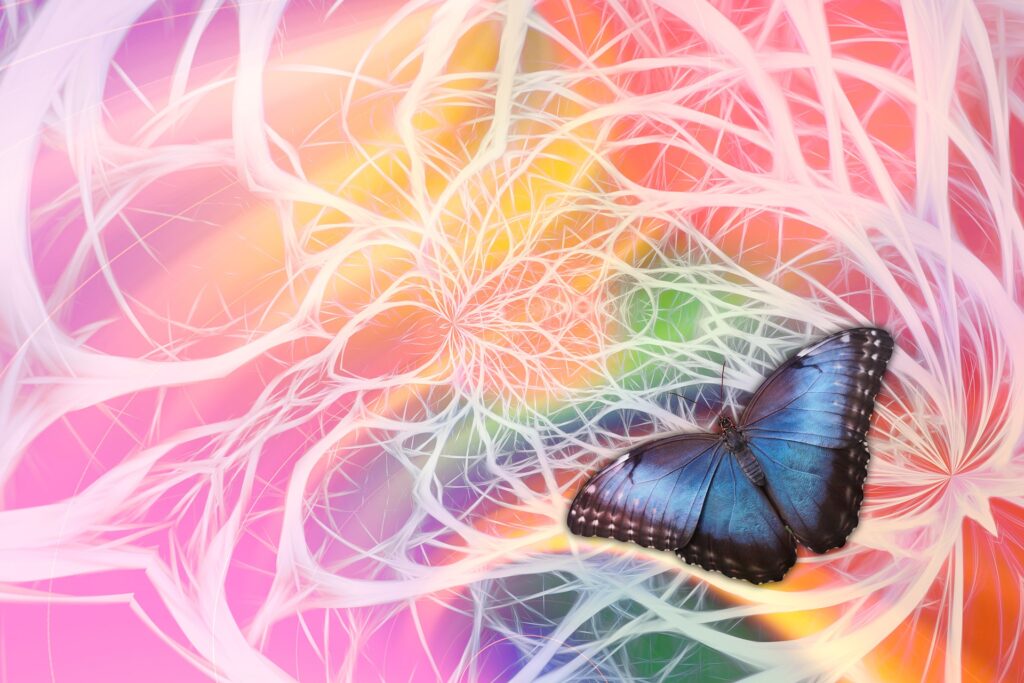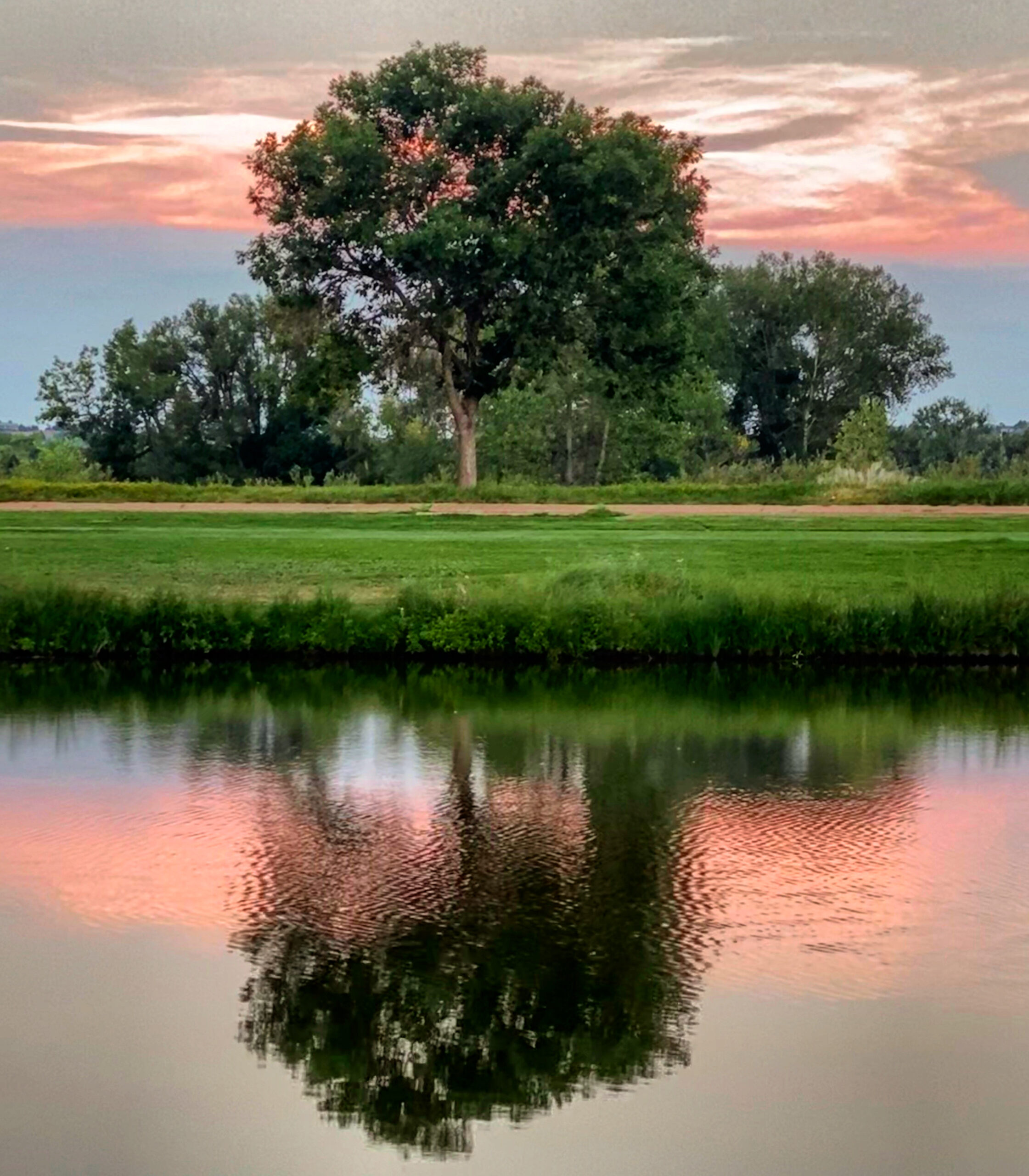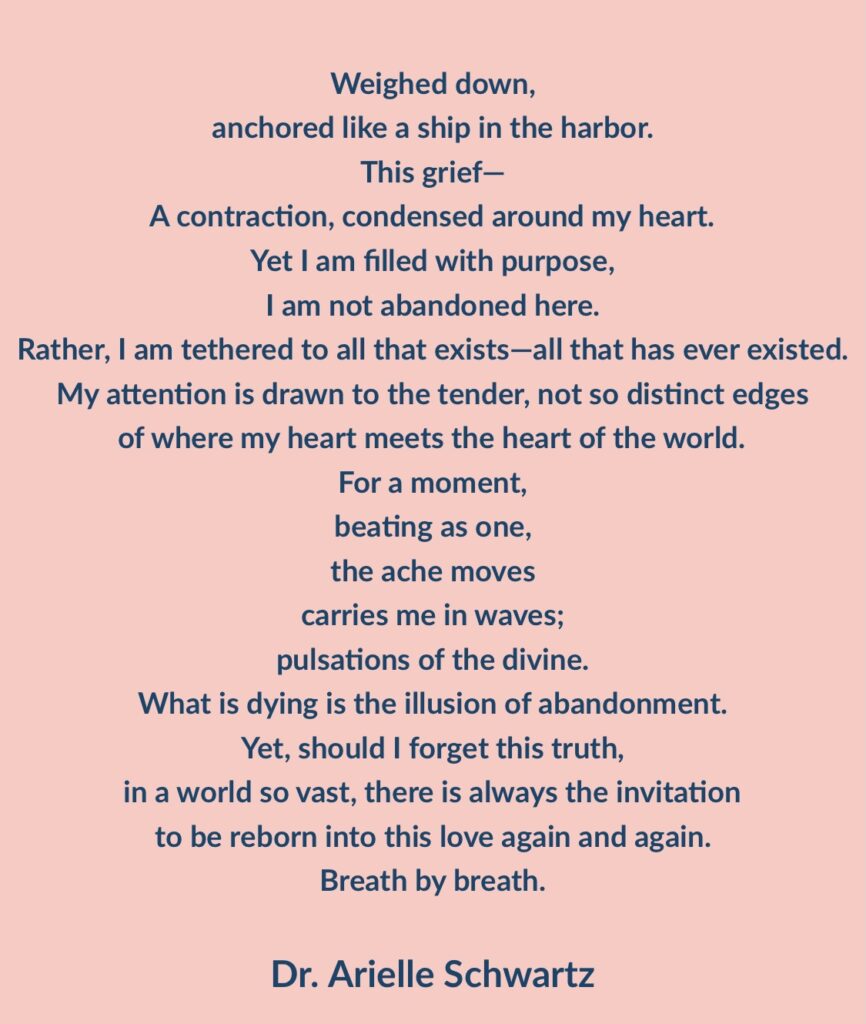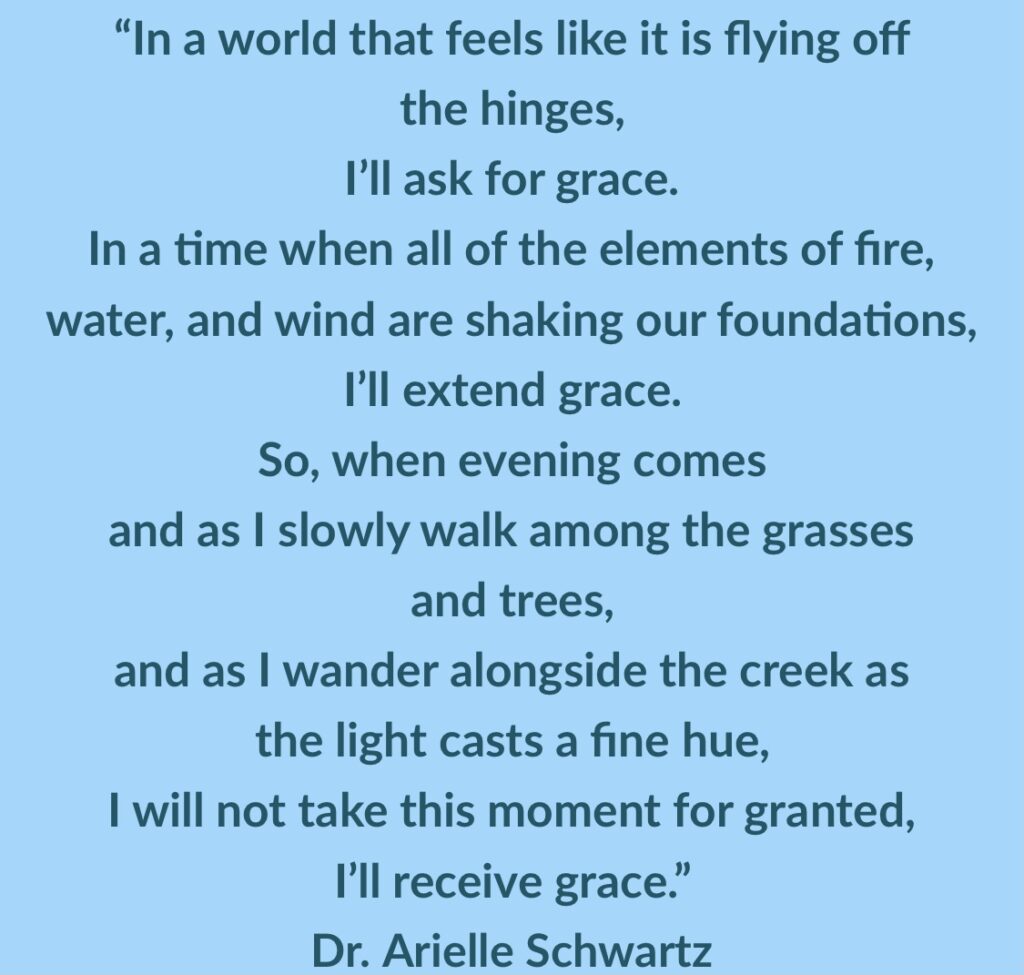
Our bodies reflect our relationship to stress. When under duress, your sympathetic nervous system kicks into gear which can lead you to breathe with quick, forceful inhalations into your upper chest. This breathing pattern prepares you to flee or fight off impending danger. There is wisdom in your body’s protective defense patterns—yet, you are not meant to live there long-term.
Ideally, we have an opportunity to reset, relax, and restore body and mind. This requires that we feel safe. Experiences of chronic stress or trauma (such as during the pandemic, as a result of systemic racism, or as a result of the ongoing impact of climate change seen in hurricanes, tornados, or wildfires) can lead us to feel keyed up in anxiety or panic for extended periods of time.
If you have experienced chronic stress of have complex PTSD, you might feel as though your resources are depleted. You might feel exhausted, depressed, and as if you cannot handle any more stress. In this case, your breathing might be shallow, your chest might feel collapsed. You may feel as though you cannot take a deep breath. This suggests that you might be relying heavily upon a defensive expression of your parasympathetic nervous system—one that conserves energy for the sake of survival.
In either case, I invite you to remember that your body is trying its very best to protect you. However, it is common to remain in defensive breath patterns when; in actuality, you will benefit from relaxing and resting. You can reclaim a sense of safety through conscious breathing and the vagus nerve will help you orient to a here-and-now sense of ease in your body and mind.

One of the primary benefits of having a regular yoga practice is the development of self-knowledge. The Sanskrit word jnana and the English word know both have etymological roots in the Greek word gnosis. Inscribed upon the entrance to the ancient Greek temple of Apollo at Delphi were the words, “know-thyself”. This phrase can be thought of an invitation to study your own character; both your limitations and your strengths. Rather than ignoring your personal limitations or vulnerabilities, you can compassionately cultivate self-knowledge as a way to best attend to your emotional, mental, and physical health.
One way that you can cultivate jnana or self-knowledge in therapeutic yoga for trauma recovery, is through observing your own nervous system states. This will help you to recognize signs of imbalances so that you may respond in a caring manner that enhances your wellness. With a history of trauma, you may be more likely to experience times when you feel anxious, panicky, restless, shaky, breathless, irritable, angry, or out of control. Or, you might also be prone to feeling fatigued, lethargic, emotionally dull, helpless, heavy, depressed, shut down, disconnected, or numb. Self-knowledge of your nervous system can allow you to respond to these varying emotions and physiological states by engaging in practices that either re-energize or relax your mind and body.
At times, your body might react to a stressful event even before you are aware of the trigger. Even without conscious awareness, your brain and body have released a cascade of stress chemicals such as cortisol and adrenaline. This is one reason why you cannot simply think your way out of the symptoms of trauma; rather, you must work with the body to maximize healing, and a regular yoga practice can play an instrumental role in this process. Dr. Porges coined the term neuroception to reflect the process by which the your vagus nerve is communicating internal and external cues about whether situations or people are safe, dangerous, or life threatening. Your nervous system will find these cues within the body, in our external environment, or in the body language, facial expressions, or voice tones or other people. For example, changes in heart rate or subtle shifts in muscle tone impact your sense of self but you might not be aware of these changes as they occur.
You can learn to pay attention to neuroceptive cues by consciously observing signs that your body is responding to a threat. For example, you furrow your brow, tighten you jaw, grip your hands, or clench your buttocks. You have an opportunity to practice neuroceptive awareness every time that you engage in a yoga practice whether you are moving in asana, resting in savasana, practicing pranayama, or seated in meditation. Neuroception can be thought of as a form of self-study (svadyaya). This process can help you to perceive changes that indicate you are reacting to stress. Importantly, there is no state of your nervous system that is bad, wrong, or damaged. Rather, I invite you to recognize that each nervous system state gives you access to different emotions and sensations.
Once you increase your perception of these sensations, you can then begin to discern whether the autonomic response you are having is a reflection of an area in your present-day life that is leading you to feel unsafe. If indeed, you are in a situation that feels threatening, you can best determine a course of actions that help you to protect yourself. On the other hand, sometimes these nervous system states are connected to memories of difficult times in the past. In this case, you might look around your space and realize that there is no current threat. Now, you can consciously let go of unnecessary defensive reactions by finding a posture that helps you release emotional tension or you might connect to your breath in a way that helps calm down your nervous system. Keep in mind that, you may not yet have the capacity to turn toward the feelings and memories related to traumatic events from the past. However, you can build that capacity over time.

“To breathe is to live. Grief is often felt as a heavy weight in the chest. We cannot take for granted the health of our body, our sense of safety in the world, of the cleanliness of our air. These precious gifts are our birthright; yet, they need to be protected. To breathe fully in the midst of intense times is an act of courage.”
Dr. Arielle Schwartz
In Traditional Chinese medicine, the lungs are associated with sadness and grief. There is a lot happening on the planet right now—covid-19, ongoing acts of violence due to centuries long systemic racism, the evidence of climate change as seen in wildfires that impact air quality. We are so deeply interconnected with each other and the earth. If you are feeling grief, you are not alone.
In the Post-Traumatic Growth Guidebook, I write this passage about grief:
“Grief is profoundly raw and, at its core, a form of social communication. Consciously making space for grief is essential if we are to heal our collective wounds. When attending to each other’s grief, it is important to remember that grief needs presence. Nothing more. It is not necessary to say the “right” thing because there is no “right” thing to say. It is not necessary to have the answer because sometimes there are no answers. It is important to simply let each other know that we are there and that we are not afraid. Sometimes this involves being there and sitting in silence, breathing, or offering a nod of reassurance. Overall, being with someone in grief is about holding an outer container so that the person in grief can go on the inward journey needed during this vulnerable time. Some days you might be receiving support, and other days you might be giving support to another. However, so long as we all play our part in this exchange, we can facilitate an interconnected web of community.”
Rollo May, author of the book, The Courage to Create, wrote that the creative act often arises out of our struggles. It takes great courage to stay engaged and open-hearted share in the midst of our pain. It is an act of valor to bring our gifts with the world in the midst of despair. It takes bravery to live in a world that has betrayed you…and that could betray you again.

You can restore healthy energy to the lungs. This is referred to as Qi in Chinese medicine and Prana in the yogic tradition. When healthy energy is restored to the lungs, we tend to think more clearly which supports our communications and actions in the world. The vagus nerve plays an important role in this link between our lungs and our wellbeing.
The Polyvagal theory, as developed by Dr. Stephen Porges, identifies that the most recently evolved part of our vagus nerve can be thought of as our social engagement system. It is that part of the nervous system that unites body and mind allowing us to feel connected to others and loving towards ourselves. When optimized, the social engagement system, helps us to be engaged in life in an empathic, open-hearted, and kind manner.
The breath plays a key role in our health because the vagus nerve extends into the smooth muscle of the lungs and heart. Recall that the sympathetic nervous system is associated with quick, intense breaths into the upper lungs…a condition often referred to as over-breathing or hyperventilation. In contrast, a long, slow exhalation initiates a vagus nerve response which sends communications to the medulla oblongata in the brainstem to inhibit over-breathing. This process initiates the Hering-Breuer reflex in which slowing down respiratory frequency leads to an increase in carbon dioxide in the bloodstream—and the medulla resets the breath rate in response to the change in CO2. Ultimately, the Hering-Breuer reflex inhibits over-breathing and helps to restore a felt sense of safety.
Pranayama refers to conscious and intentional breathing practices within the yogic tradition that help you strengthen your connection to your Self. The word pranayama can be understand to have several different meanings. The Sanskrit word prana refers to the breath as connected to your vital life-force energy. The word yama, as discussed earlier, means control. With this in mind, you can think of prayanama as “breath control.” However, the Sanskrit word ayama is translated as liberation. In this context, we can think of pranayama as a practice to liberate your vital life-force energy.
Traumatic events tend to have a significant impact on the way we breathe. As a result, connecting to your breath might bring up difficult emotions or memories from the past. Pranayama can be a powerful healing tool; however, it may feel difficult to trust this process especially when the first sensations are uncomfortable. Feeling some degree of discomfort is a sign that you awakening your body-mind connection; however, healing requires that you have sufficient support. Moreover, it is important to know that you can take breaks from any breath practice and return as you feel ready.
Some pranayama practices focus on diaphragmatic or “belly” breathing with a long, slow exhale. Other practices focus on breathing rapidly in and out of the nose such as a “breath of fire.” There are breathing practices such as Buteyko that emphasize a light, barely perceptible inhalation and exhalation in and out of the nose and holding the breath out. And, there is Wim Hoff breathing which involves a bellows breath in and out of the mouth resolving into a long (up to several minutes) holding of the breath out followed by holding the breath in at the top of an inhalation. (Note that these retentions of the breath might be particularly triggering if you had events in the past in which your breathing was restricted or limited.)

After many years of being an experienced yoga and pranayama practitioner and teacher I have an important conclusion…there is no single right way to breathe.
We have different states of our nervous system. Each helps us to manage different situations. We are meant to cultivate nervous system flexibility which means that we can tolerate a range of different arousal states without becoming stuck in hyper- or hypo-arousal states. There are many, many different breathing patterns taught in pranayama. Each serves us in different ways and we can draw upon different strategies of breathing at different times to facilitate our wellbeing. Some are energizing, some facilitate relaxation, some are cleansing, and some create a balanced mind and body.
Most importantly, you need to know your body and your signals of nervous system health. This requires that you build a conscious relationship to the many ways that your body communicates with you throughout the day. You can learn to listen to your body’s signals that indicate that you need food, water, movement, touch, and rest. As you experiment with breathing practices, you also learn to listen to your body’s feedback about which breath practices serve your goals at any given moment. “Conscious Breathing and the Vagus Nerve” means that you listen and connect to your truth…the wisdom inherent in your body!

While you do not have lungs that extend into our hips or legs, you can imagine breathing into these areas as a way to bring your conscious awareness into these places. This is a powerful practice when you have areas of your body that feel tight, constricted, painful, or numb. Your breath is a signal that you are paying attention. Remember, yoga invites you to create union between your body, breath, mind, and soul. Using intentional breathing, you are creating these connections
Take a few moments to reflect upon your relationship to your breath. Are you aware of any ways that traumatic events from the past have changed how you breathe? Do you notice if you tend to hold your breath, breathe shallowly, or find it difficult to take a deep full belly breath?
Now, notice if there is a particular area of your body where you are holding tension? For the next two or three minutes begin to breathe into and listen to this area of your body. As you send your breath into this area notice any sensations that arise. What does this area of your body need? Would it be helpful to place a hand over this area of your body as you breathe? How does this part of your body want to move? Continue to breathe intentionally into this area of your body. You might notice new sensations in other areas of your body or emotions that come to the surface of your awareness. Now, you can send your breath into these areas of your body. Remember, you can take breaks from the practice as needed. Follow your intuition. You might choose to stay with the practice longer. Whenever you are complete, take some time to write down any observations knowing that you can return to this practice as often as you would like.
I’ll close with a few final words, a poem and prayer that accompanies me during my evening walks. May these words invite you to embrace the heaviness of your own grief without fear and may they also allow you to experience a gentle breath, a moment of grace:


Learn more about therapeutic yoga, conscious breathing and the vagus nerve:
Therapeutic Yoga with Dr. Arielle Schwartz

Dr. Arielle Schwartz is a licensed clinical psychologist, wife, and mother in Boulder, CO. She offers trainings for therapists, maintains a private practice, and has passions for the outdoors, yoga, and writing. She is the developer of Resilience-Informed Therapy which applies research on trauma recovery to form a strength-based, trauma treatment model that includes Eye Movement Desensitization and Reprocessing (EMDR), somatic (body-centered) psychology and time-tested relational psychotherapy. Like Dr. Arielle Schwartz on Facebook, follow her on Linkedin and sign up for email updates to stay up to date with all her posts. Dr. Schwartz is the author of four books:

Arielle Schwartz, PhD, is a psychologist, internationally sought-out teacher, yoga instructor, and leading voice in the healing of PTSD and complex trauma. She is the author of five books, including The Complex PTSD Workbook, EMDR Therapy and Somatic Psychology, and The Post Traumatic Growth Guidebook.
Dr. Schwartz is an accomplished teacher who guides therapists in the application of EMDR, somatic psychology, parts work therapy, and mindfulness-based interventions for the treatment of trauma and complex PTSD. She guides you through a personal journey of healing in her Sounds True audio program, Trauma Recovery.
She has a depth of understanding, passion, kindness, compassion, joy, and a succinct way of speaking about very complex topics. She is the founder of the Center for Resilience Informed Therapy in Boulder, Colorado where she maintains a private practice providing psychotherapy, supervision, and consultation. Dr. Schwartz believes that that the journey of trauma recovery is an awakening of the spiritual heart.